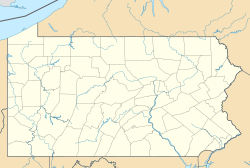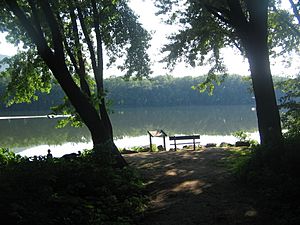Canfield Island Site facts for kids
Quick facts for kids |
|
|
Archeological Site 36 LY 37
|
|

Canfield Island and the West Branch Susquehanna River, as seen from Bald Eagle Mountain
|
|
| Location | Canfield Island in the West Branch Susquehanna River, near Williamsport, Pennsylvania |
|---|---|
| Area | 21 acres (8.5 ha) |
| NRHP reference No. | 82003799 |
| Added to NRHP | April 14, 1982 |
The Canfield Island Site, also called Archeological Site 36LY37, is an exciting archaeological site in Lycoming County, Pennsylvania, United States. It is found on Canfield Island in the West Branch Susquehanna River. This special island is located east of Williamsport in Loyalsock Township. Experts believe that Native Americans lived here for thousands of years. The oldest things found here are from more than a thousand years before Christ!
Contents
How Canfield Island Was Formed
Canfield Island is not a natural island. It was made by people in the early 1900s. Workers dug a canal next to the West Branch Susquehanna River. This canal now forms the northern edge of the island. The river itself forms the southern edge.
Much of the island was used for farming in the past. Today, many parts of the island are covered by forests. The river often leaves new soil and sediment on the island. This helps the island grow and change over time. The island covers a total area of 21 acres (8.5 ha).
Digging Up the Past: Archaeology at Canfield Island
People first thought Canfield Island might be an important archaeological site in 1958. This was after a group from the Society for Pennsylvania Archaeology visited it. Starting in 1960, archaeologists began to dig. They continued digging on and off until 1980.
During these excavations, they found artifacts as deep as 15 metres (49 ft) below the surface. They also found artifacts scattered all over the island's surface. Even after 1980, people have continued to study the site. For example, a team from Lycoming College dug there in 2003.
The discoveries at Canfield Island are very special. They show a more complete timeline of human life than many other sites in Pennsylvania. While ceramic pottery is rare here, there's a lot of charcoal. This charcoal helps scientists figure out the age of things found at other sites in the state.
Another amazing discovery was many large hearths (ancient fireplaces). Near these hearths, they found lots of fishing nets. This suggests that Canfield Island was a very important place for fishing long ago.
What We Learned from the Discoveries
Archaeologists have learned a lot about who lived on Canfield Island. They found evidence that people lived there during the Late Archaic period. This was about 3,000 years ago. They also found a piece at the very bottom of their digs. This piece might be from an even older time, the Early Archaic period.
Evidence shows that people lived on the island during different parts of the Woodland period. There is also proof that the Susquehannock people lived there. The Susquehannock were still living in eastern Pennsylvania when Europeans first arrived.
Recognizing Canfield Island's Importance
In 1982, Canfield Island was added to the National Register of Historic Places. This was because it had already given us so much information. It also has the potential to teach us even more about the past.
Today, the site is part of Riverfront Park. This park is managed by Loyalsock Township. The island has a special archaeology-themed trail for visitors to explore. Since 2003, local Native American groups have held an annual pow-wow on the island. This event celebrates their culture and history.





